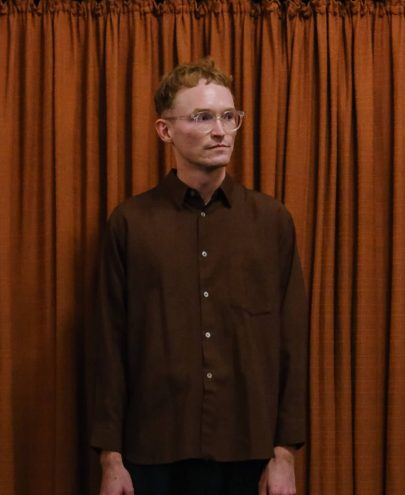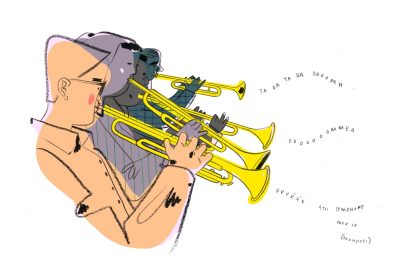Apr 14, 2013 Music
Auckland Philharmonia Orchestra
Auckland Town Hall
April 11, 2013
“Obsessive composer gives audience worst night of lives”. The 1808 premiere performance Beethoven’s Fifth Symphony makes a great story. It also makes a useful story. It tells you so much. I wish Graham Abbott had told it better.
Abbott is an Australian conductor and broadcaster; he presents a weekly radio show unpacking the history and inner workings of great music, and he’s been the regular front man for the APO’s Unwrap The Music series for three years now. These one-hour, early evening concerts take a single work and explain where it came from and what’s going on inside it, with lots of talking, lots of brief musical illustrations, and a full performance of each movement of the piece.
It’s an excellent concept, and one of the many ways in which the APO are already doing all the things the government has recently told them they need to do in order to be a proper “metropolitan orchestra”, i.e. one worthy of enough funding to pay their musicians something more nearly approximating a decent wage. I can’t imagine a better piece to put under the microscope than Beethoven’s Fifth, “music’s Mona Lisa“, as Abbott put it.
Though the stronger comparison might be with Hamlet: everyone knows “To be or not to be”, and everyone knows the Fifth’s opening bars, but – in both cases – fewer people these days know the magnificent complexities that follow. Clearly there’s an appetite to know more; APO concerts are generally well attended, but this one was packed, and with a more diverse crowd – more teens, many more people in their twenties and thirties – than I tend to see at the subscription series.
The very first thing that happened once Abbott hit the stage was a feedback squeal from his hand-held microphone. Not a great start, and a harbinger of annoying amplification quality issues to come; the slightly hard-of-hearing couple next to me missed most of what Abbott had to say throughout the concert, though they could hear the orchestra perfectly well.
Ironically enough, the symphony’s premiere also had technical problems. It was a bitter mid-winter night in Vienna, and the hall was poorly heated. The audience nearly froze. The Fifth was badly under-rehearsed, and it was presented mid-way through a concert that lasted four hours. What makes this so delightful is that the programme was designed and conducted by Beethoven himself.
Abbott kicked off with this story. Well, no: he kicked off with, “You might have heard the piece before, it starts like this”, after which the orchestra thundered through the first five bars – a nice example of the fluid way music and speech interwove throughout the evening. But then he told the premiere story, and he brought out the gorgeous absurdity of it pretty well.
The great man is given a rare chance to programme his own music, and decides to thrill his soon-to-be-shivering audience with not one new symphony, but two. And a piano concerto. (He played the solo part). And three movements of the C Minor Mass. And an operatic aria. And a solo piano improvisation. (Featuring… well, guess). And a new piece for choir, orchestra and solo piano (as played by…) that he composed three days before the concert, worried that the Fifth didn’t have a strong enough ending to be the last thing on the bill.
Let’s just repeat that: Beethoven was worried that the ending of the Fifth, one of the most exhilarating examples of sustained, focused adrenaline expenditure in the whole symphonic repertoire, might not be climactic enough to impress the audience. Imagine someone standing on the peak of Everest, muttering, “I really thought the view would be better”.
So he composed a whole new piece of music (the Choral Fantasy), with no time to rehearse it, and shoved it in front of his by now thoroughly exhausted and irate performers, and was surprised when his equally exhausted and irate audience rose to their feet only for the purpose of getting home to their fireplaces as quickly as possible. The programme which launched the Fifth into the world, one is forced to conclude, was put together by a maddened obsessive.
Which is perfect, because obsession is the state of mind in which small things expand to fill your field of view and all perspective vanishes, and this state of mind is where the Fifth lives. It’s where it came from. The minor disappointment I took away from Abbott’s concert-lecture was that he never teased out this connection: he told us the premiere story as an amusing historical anecdote, and he did an excellent job of showing how the Fifth takes a single, tiny musical idea (the famous opening four-note rhythm) and zooms in on it until it becomes a conceptual universe. It would have been so much more elegant and effective to allow the anecdote a chance to enrich the music theory.
It was a given, though, that Abbott was never going to do everything I wanted him to. He had only an hour – and it’s a well-judged length for this sort of event – in which to conduct the whole of the symphony and dissect and explain all four of its movements. People write PhDs on those movements. And the audience could reliably be presumed to include people who had never heard the words “key signature” or “sonata form”, as well as people who were currently in the middle of writing some of those PhDs.
A popular lecture on a great work of art that will simultaneously entertain experts and inform novices is a difficult thing to pull off. Abbott is a pretty good public speaker who clearly knows his music, and in bringing out the relationship of the opening four-note theme to its subsequent reiterations, he did manage to do the most useful thing he possibly could have.
It’s hard to overstate, also, how powerful a teaching method it is to put a full symphony orchestra at the disposal of a good lecturer. At one point Abbott mentioned that a few early reviewers accused Beethoven of lifting the spectral opening phrase of the scherzo from Mozart’s 40th symphony. “See what you think”. The orchestra played the relevant bit of Mozart – which is famous, and instantly recognisable, and not more than slightly reminiscent of the Beethoven passage. Then Abbott told us about the recent discovery that Beethoven’s notebooks contain an early sketch for the scherzo alongside a copied-out quotation of exactly this section of the Mozart.
As a way of illustrating how an idea – in this case a rising arpeggio figure – can be picked out of a piece of music and transformed, this could hardly have been more effective. By leaving the notebook revelation until after we’d heard the two passages played, Abbott gave us a much better chance of grasping how a composer can seize on something in someone else’s music and use it as the basis for something with a completely different mood and impact.
At the end of the evening I was left wanting more of these compare-and-contrast examples, which is how it ought to be: if a one hour lecture on Beethoven’s Fifth leaves you feeling either that you’ve heard all there is to hear, or that you wouldn’t have wanted to be told any more, something’s wrong.
But the strongest compliment to Abbott, and to the Unwrap the Music concept, came when the orchestra were finally unleashed from illustrative bit-piece playing and allowed to perform the final part of the symphony. I used to play various recordings of this music over and over when I was a teenager. I’ve heard it live I don’t know how many times.
But this time there were two giant screens showing close-ups of various sections of the orchestra, and I’d just spent most of an hour listening to Abbott and thinking about symphonic structure. I heard things I’d never heard before.
Photo by Adrian Malloch.





